La Dolce Vita: Masculinity and Tailoring | Clothes on Film
© 2011, Clothes on Film 
La Dolce Vita (directed by Federico Fellini) was released in 1960. It has been described as a groundbreaking film, capturing a time of reconstruction and economic growth in Italy, linked to the end of Fascism and the destruction caused by the Second World War.
Despite the availability of colour stock, La Dolce Vita was shot in black and white. The use of monochrome appears to emphasise the diametric oppositions between the old rural way of life and the new modernising Italy. La Dolce Vita looked firmly forward to the future, introducing an international audience not only to sleek and sophisticated Italian fashions but also a profession of which we are now thoroughly familiar; the unscrupulous celebrity photographer.


The overall look of La Dolce Vita was created by Piero Gherardi. On the credits he is listed as the designer of sets and costumes and separately as the Art Director. His stylish and innovative work on the film was recognised in 1962 when he won an American Academy Award for Best Costume Design. La Dolce Vita is an interesting picture to analyse because Gherardi attached equal importance to male and female costumes. With Mastroianni, Gherardi had a strong male lead to work with whose character is underpinned by his individual sense of style, reflecting fashionable Italian menswear of the period.
When La Dolce Vita was shot, Italy was not an industrialised country and therefore lounge suits would have been made to measure by individual tailors. The Italian style suit had some unique features; trousers were slim fitting with narrow legs, the jacket was single breasted and also slim fitting. This is a contrast to the American Ivy League style of the period worn by Gregory Peck’s journalist character in Roman Holiday (seen below) from 1953. The Ivy League style was epitomised by looser fitting trousers with forward pleats and a loose jacket, which could also be double-breasted. Ivy League style was all about conservatism and comfort whereas the Italian style recognised that a flattering fit signified masculine sophistication.
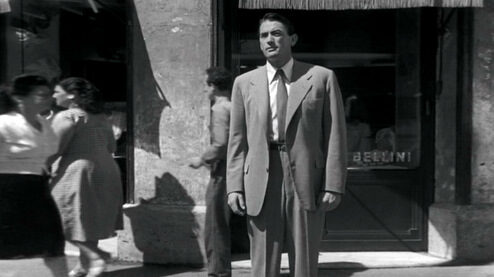
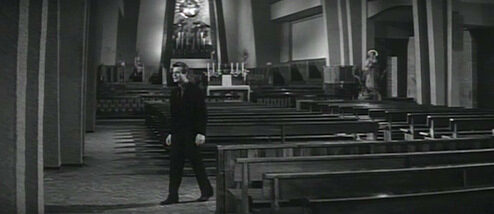
We first encounter Italian styling in the opening scenes of La Dolce Vita. Architectural structures from both classical and contemporary Rome form the backdrop for the emergence of two helicopters, one carrying below a figure of Christ, the other carrying a journalist and photographer documenting the event.
The journalist and male lead is Marcello Mastroianni who plays society scribe Marcello Rubini. In the opening scene his brand of sexually alluring masculinity is immediately established by designer Gherardi. Marcello is chic, expensively dressed and yet casual as he wears a dark shirt and tie, accessorised with large cufflinks and dark glasses. By making the accessories noticeable, Gheradi helps the audience to recognise that this character pays attention to detail, thus establishing him as a credible reporter.
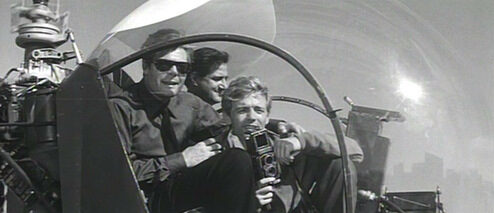
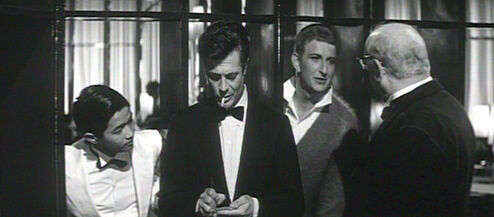
We also get a sense of Marcello as a playboy with his slicked back hair that miraculously remains in place when he leans out of the hovering helicopter and converses with three women in swimwear (who just happen to be sunbathing on top of a building). Marcello still looks dapper as the audience encounters him later that same evening entering a nightclub. He is still wearing dark glasses, but with a fitted tuxedo and narrow bow tie which further confirms the sartorial articulacy of his character. Marcello then meets the socialite Maddelena (Anouk Aimee), his equal in terms of both elegance and moral depravity.
Rome is shown to be a vibrant, busy city at night, and as they leave the club Marcello and Maddelena pick up a female stranger, driving her home to ‘Dead Souls’. The stranger, it emerges, is a prostitute, she refers to Marcello as ‘Gregory Peck’ which aligns him to Peck’s depiction of an alpha male journalist in Roman Holiday.
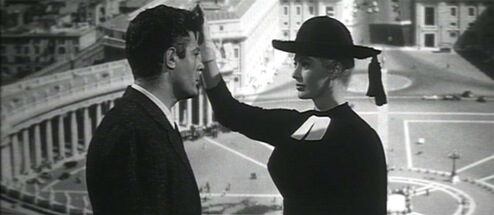

Following a night spent with Maddelena, Marcello is still immaculately dressed, his bow-tie tied, his hair slicked into place. Later the following evening, one of the most iconic scenes in the film takes place as blonde bombshell and American actress Sylvia (Anita Ekberg) dances in the Trevi fountain. Sylvia beckons Marcello to join her and appears to baptise him by placing a few drops of water on his head. She is drenched and dishevelled but Marcello’s tailored suit is still intact leaving him composed and in control.
Mastroinanni’s role in the film can be viewed in part as a discourse on Italian male identity which highlights a particular Western stereotype: the Latin lover. It could also be argued that Marcello is a type of flaneur, as Walter Benjamin stated, ‘the social base of flanerie is journalism’. The flaneur was the quintessential Nineteenth century Parisian man, active and intellectual; unlike the respectable women of his class, he had the freedom to roam the city. He was an observer and interpreter of the age of Modernism who found meaning in urban life.
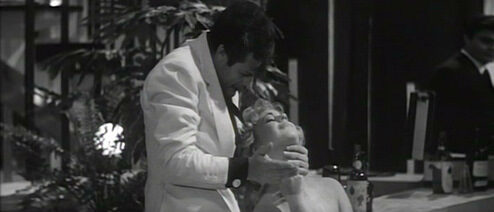

As a journalist, Marcello is a flaneur wearing dark suits and formal clothing and observing life from the shadows. However, by the end of the film he is transformed and his all white suit and contrasting black shirt signify a desire to be noticed as a central character. It would seem that La Dolce Vita offers a conflicting portrayal of masculinity.
At the climax, Mastroianni appears vulnerable and damaged but also dangerous in the black shirt and white linen suit. As an observer we feel that because his appearance has changed so dramatically, anything is possible for his character.
By Suzanne Rowland, a lecturer in Art and Design. Read more of Suzzane’s work at Dress History.
You can watch movies online including Marcello Mastroianni in La Dolce Vita at LOVEFiLM.com.
© 2011, Contributor.
Related Posts: